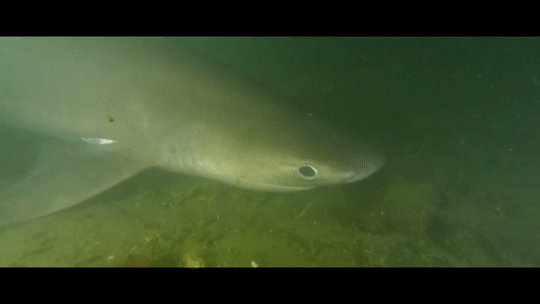#s. suckleyi
Photo

Local sixgill startled by speedy squalus suckleyi
#chondrichthyes#elasmobranch#euselachi#hexanchiformes#squaliformes#hexanchus griseus#squalus suckleyi#pacific spiny dogfish#bluntnose sixgill shark#h. griseus#s. suckleyi#sharks#fish#puget sound#redondo#poverty bay#whulge#wa#washington
476 notes
·
View notes
Photo

noped tf outta there
#hexanchus griseus#squalus suckleyi#squalus acanthas#eukarya#animalia#chordates#chondrichthyes#elasmobranchs#selachimorpha#hexanchiformes#squaliformes#hexanchidae#h. griseus#squalidae#s. suckleyi#s. acanthas#nope#shitpost#meme#gif
32 notes
·
View notes
Text
youtube
INCREDIBLE new footage from John Sanders at Redondo!!!
Here's why:
The question is up in the air as to whether the bluntnose sixgill shark (Hexanchus griseus) is a primarily a predator or scavenger. The answer is likely both when looking at other predators in its niche, but this footage is another key to confirming the hypothesis that they are primarily scavengers.
In the past, H. griseus has been recorded ingesting crabs and spitting them out at a bait station specifically for the crabs. This was interesting to me because crustaceans supposedly make up a decent portion of their diet. Why wouldn't the observed shark eat the crabs even if it couldn't get the fish meat inside the trap?
A more recent study, which I also wrote about, found tissues from a young dolphin in the stomach of an H. griseus from the western Mediterranean Sea. These are not fast sharks. There were not brittle stars or other scavenging organisms in the stomach, suggesting that the shark got to the dolphin before the others, if it was scavenged and not predated. Among other little details that I go into further detail in that post.
To the point: In this video, we see three H. griseus at a bait station crowded with pacific spiny dogfish (Squalus suckleyi) and red rock crabs (Cancer productus). There was one Dungeness crab (Metacarcinus magister) and one flatfish that may be a rock sole (Lepidopsetta bilineata) or an English sole (Parophrys vetulus). All gathered to feed on the salmon meat placed by the divers. Repeatedly in the footage, we see the H. griseus ingest crabs and spit them out alive.
Why? Well, it appears that they are only interested in the salmon flesh and may have been trying to steal the morsels that the crabs were pinching away at. In one instance, an H. griseus goes for a whole gathering of crabs. Doesn't eat a single one. Now, to draw any conclusion from this would require a lot of assumptions. I assume that these crabs had salmon meat in their claws and I assume that the sharks got the flesh before spitting the crabs out. That need not be the case to still support my hypothesis that these sharks are primarily scavengers.
These sharks had multiple opportunities to eat any number of the other visitors to the feast. In one moment, an S. suckleyi was right at the rostrum of one of the H. griseus and the latter didn't even try to eat the former. This could be because S. suckleyi has venomous spines; perhaps it is learned or instinctual not to try and eat them. But then there's the C. productus. Other that having a slippery carapace, there is little the crab could do that would prove fatal if eaten live. And then there's the flatfish, which has no natural defenses or hazards.
All of this points to scavenger behavior.
I am blown away by this footage (and extremely envious of this diver). Even though my ROV is OOC, I still get observe these sharks in one way or another.
#eukarya#animalia#chordates#chondrichthyes#elasmobranchs#selachimorpha#hexanchiformes#hexanchidae#hexanchus griseus#h. griseus#c. productus#cancer productus#red rock crab#metacarcinus magister#m. magister#dungeness crab#pacific spiny dogfish#squalus suckleyi#s. suckleyi#english sole#parophrys vetulus#p. vetulus#rock sole#northern rock sole#southern rock sole#lepidopsetta bilineata#l. bilineata#john sanders#redondo#wa
9 notes
·
View notes
Text

This is really funny to me, considering that Squalus suckleyi are hypothesized to be prey of Hexanchus grieus due to their matching vertical diel movements in Puget Sound. Lil guy's lucky she wasn't hungry!
#chondrichthyes#elasmobranch#euselachi#hexanchiformes#squaliformes#squalus suckleyi#hexanchus griseus#h. griseus#s. suckleyi#pacific spiny dogfish#bluntnose sixgill shark#cow shark#puget sound#wa#washington#redondo#gif#shitpost#meme
67 notes
·
View notes
Link
What I learned from this is that subadult bluntnose sixgill sharks may be following their preferred prey (spotted ratfish--a type of chimera--and spiny dogfish sharks) seasonally; with them being more abundant in shallower inland waters in summer and fall, and becoming less abundant in these areas in winter and spring.
The actual data on the abundance of sixgills in Puget Sound is a bit inconclusive. Most of the sharks that visited their research site could not be confidently identified as being that same shark, or not. Meaning the actual number produced for abundance is an underestimation.
It's likely that most of the sixgills in the study were siblings and half-siblings,
I also identified two gaps in understanding that open up opportunities for additional research. Those being:
- Uniqueness of Subadult Sixgill Residency in the Northeast Pacific (are there other inland estuaries around the world where subadult sixgills are born and remain until maturity)
- Primary Feeding Method
How one is to track a sixgill shark, visually, for long enough periods of time in order to determine the latter is up in the air. Both human and technological limitations would make it difficult, but I'm sure there's a way.
#chondrichthyes#elasmobranch#holocephali#euselachi#hexanchiformes#hexanchus griseus#h. griseus#squaliformes#squalus suckleyi#chimaeriformes#hydrolagus colliei#spotted ratfish#pacific spiny dogfish#s. suckleyi#h. colliei#cow shark#sharks#chimaera#fish#puget sound#strait of georgia#wa#washington#bc#british columbia#salish sea
1 note
·
View note